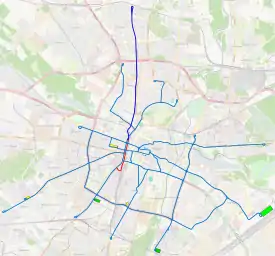Trams in Poznań
The Poznań tram system is a tramway operated by Miejskie Przedsiębiorstwo Komunikacyjne w Poznaniu Sp. z o.o. (MPK Poznań; Public Transport Company in Poznań Ltd.). It currently has 20 daytime lines, one night line, and one tourist line served by historical vehicles. The tram system consists of about 66 kilometres (41 mi) of route, operating on 1,435 mm (4 ft 8+1⁄2 in) standard gauge track. With a few exceptions the tramlines operate on double tracks rail.
| Trams in Poznań | |||
|---|---|---|---|
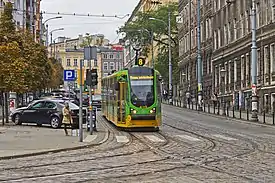 Tram at Podgórna Street in Poznań | |||
| Overview | |||
| Native name | Tramwaje w Poznaniu | ||
| Owner | City of Poznań | ||
| Locale | Poznań, Poland | ||
| Transit type | Tram | ||
| Number of lines | 21
| ||
| Website | www MPK Poznań | ||
| Operation | |||
| Began operation | 30 July 1880 (horsecar) 6 March 1898 (electric tram) | ||
| Operator(s) | MPK Poznań | ||
| Number of vehicles | ~430 (81 low-floor) | ||
| Technical | |||
| System length | 66 km (41 mi) (2011) | ||
| Track gauge | 1,435 mm (4 ft 8+1⁄2 in) | ||
| |||
In local Poznań dialect trams are called bimby (pl.), bimba (sing).
History
Horse trams (1880-1898)
The idea of trams in Poznań was brought to fruition by two businessmen from Berlin: Otto Reymer and Otto Masch. After receiving concessions from the town authorities on 30 July 1880 they began running a horse tram in Poznań. On the next day the first regular line transported passengers from the main train station via ul. Św. Marcin/St. Martin Str., ul. Rycerska/Ritter Str. (today ul. Ratajczaka), Pl. Wilhelmowski/Wilhelms Platz (currently Plac Wolności) to Rynek/Ring (currently Stary Rynek English: Old Market). The route was soon lengthened from Rynek/Ring to ul. Butelska/Büttel Str. (now ul. Woźna), ul. Wielkie Garbary/Grosse Gerber Str. (currently ul. Garbary), Chwaliszewo to Ostrów Tumski. At the same time a branch was built via ul. Wiktorii/Victoria Str. (modern ul. Gwarna and ul. Mielżyńskiego), Plac Królewski/Königs Platz (currently Pl. Cyryla Ratajskiego), ul. Fryderykowska/Friedrich Str. (modern ul. 23 Lutego), Al. Wilhelmowskie/Wilhelms Al. (currently Al. Marcinkowskiego), ul. Seekta/Seekt Str. (modern ul. Solna) and Wolnica, ul. Małe Garbary/Kleine Gerber Str., ul. Szewska, ul. Szeroka/Breite Str. (currently ul. Wielka) to ul. Wielkie Garbary/Grosse Gerber Str. (modern ul. Garbary) where it joined the older route.
Despite the need for modern public transport in the city, after a few weeks the company found itself on the edge of bankruptcy. There were two reasons for this: firstly the branch route had too few passengers, and secondly all the signs in the trams were only in German, leading to a boycott by the Polish majority. The financially troubled company was bought by the Poznań Horse Railway Society (Polish: Poznańskie Towarzystwo Kolei Konnej, German: Posener Pferde-Eisenbahn-Gesellschaft), which obtained a concession and monopoly on tram transportation in the city. At that time there were only 20 cars in service.
In September 1880 the Society bought part of the site of the former train station in Jeżyce/Jersitz suburb, where a tram depot was built (currently it is the oldest tram depot still in service in Poland). In 1896 two new routes were built. The first ran from Rynek/Ring (now Stary Rynek), via ul. Wrocławska/Breslauer Str., Pl. Piotra/Peters Platz (now Pl. Wiosny Ludów), ul. Półwiejska to Brama Wildecka/Wilda Thor. The second went from the tram depot on ul. Gajowa, through ul. Zwierzyniecka/Zoologisher Str., ul. Jadwigi/Hedwigs Str. (modern ul. Kraszewskiego) to Rynek Jeżycki/Jersitz Markt, after one year extended via ul. Wielka Berlińska/Grosse Berliner Str. (modern ul. Dąbrowskiego) to the chemical factory on ul. Polna/Feld Str. Both routes were already built to carry heavier electric cars.
Electric trams
On 6 March 1898 horse trams were replaced by electric ones. At this time there were three lines:
- white - like the old horse tram from the train station via Rynek/Ring to Ostrów Tumski
- red - from Rynek Jeżycki/Jersitz Markt via ul. Jadwigi/Hedwigs Str., ul. Zwierzyniecka/Zoologischer Str., ul. Św. Marcin/St. Martin Str. and along the old horse tram route to Rynek/Ring and Brama Wildecka/Wilda Thor
- yellow - from the train station like the white line but only as far as the intersection of ul. Szeroka/Breite Str. and ul. Wielkie Garbary/Grosse Gerber Str.
In April a fourth line was added:
- green - from Rynek/Ring via ul. Św. Marcin/St. Martin Str. and the new route on ul. Głogowska/Gloger Str. to Górczyn suburb (today's intersection of ul. Głogowska and ul. Kosynierska).
A ticket cost 10 or 20 pfennigs and after 11 pm the price was doubled.
In 1899 a second track was added to the routes on Rynek/Ring and ul. Wielka Berlińska/Grosse Berliner Str. (modern ul. Dąbrowskiego).
Before World War I the tram network was extended to the Municipal Slaughterhouse on ul. Wielkie Garbary/Grosse Gerber Str., to Plac Sapieżyński/Sapeicha Platz (today Plac Wielkopolski), to Brama Dębińska/Eichwald Thor (currently the intersection of ul. Strzelecka and Krakowska), to Śródka, Sołacz and Dębiec (to the Cegielski Factory). New routes were also built in the centre of the city, including overpasses over the railway tracks: Most Teatralny and Most Dworcowy.
Between the wars new routes were built to Golęcin, Dębiec (extension of existing tracks), Dębina (to the public beach on the bank of the Warta), Ogrody, Grunwald and Winiary. In this same period some routes in the narrow streets of the Old Town were closed. A planned route to Główna was cancelled due to the opening in 1930 of a trolleybus line there.
After World War II


During the battle of Poznań in 1945, most of the cars and tracks were destroyed. Tram transportation was partially restored two years after the war, in 1947, though only on the left bank of the Warta. The tracks in the old town were not rebuilt, but a new route was laid via Plac Bernardyński.

The first post-war tram on the right bank appeared in 1952, when the new Marchlewski Bridge was opened (now called Most Królowej Jadwigi).
In the following years new routes connecting different districts and bypassing the centre of city were built:
- 1955-1957 via ul. Marchlewskiego (now ul. Królowej Jadwigi)
- 1968-1973 via ul. Przybyszewskiego, ul. Reymonta and ul. Hetmańska
- 1974-1977 from Plac Wielkopolski via ul. Małe Garbary, ul. Estkowskiego to Rondo Śródka.
- 1983-1985 from os. Lecha via ul. Jedności Słowiańskiej (today Chartowo and Żegrze) to ul. Hetmańska
Also some lines to peripheral districts were built:
- 1949-1950 to the communal cemetery in Junikowo
- 1957-1964 via ul. Pułaskiego and ul. Winogrady to ul. Wilczak (a branch to ul. Serbska was added in 1974)
- 1955 from Rataje to the Stomil Factory in Starołęka, in 1967 extended to 'Poznań Starołęka' train station
- 1959 to Zawady via Śródka with a branch to os. Warszawskie, extended in 1974 to Miłostowo
- 1979 to Chartowo and Osiedle Lecha
- 1980 to Winiary and ul. Piątkowska
A revolution for public transport in Poznań was brought about by the opening in 1997 of the 6.1 km long Poznański Szybki Tramwaj (English: Poznań Fast Tram) route, nicknamed "Pestka" by locals. Currently there are several plans for extension of the network, at different stages of preparation. Of great importance for tram transportation in Poznań was the general strategy for city development from 1994. According to this document trams are to serve as the fundamental mode of transport in the city. Since then, during renovations of streets and traffic lights, trams have been given right of way at intersections.
On 14 August 2007 a long new route opened, as the first section of the so-called Ratajski Szybki Tramwaj (English: Rataje Fast Tram). The new route connects Plac Wiosny Ludów via ul. Podgórna, ul. Dowbora Muśnickiego, ul. Mostowa, Most św. Rocha and ul. Kórnicka to ul. Jana Pawła II.
In 2011, MPK decided to sell 40 type 105Na trams due to lack of space in the depots for this type of trams. In addition, 45 Solaris Tramino trams were ordered along with 7 Moderus Beta trams.
On 11 August 2012 the final section of the route to Franowo opened, connecting the area of the former terminus loop at os. Lech with a new loop in Franowo. Part of the route runs through the 800m Franowo tunnel. At Franowo there is also a large, modern depot.
On 1 September 2013 an extension of the PST route was opened which runs parallel to the railway line between Poznan Główny station and Głogowska. This uses space that became available from the former platform 7 at the station.
In 2019 all remaining Konstal 105Na and Duewag GT8 trams are scheduled to be replaced by newer Moderus Gamma LF02AC trams
Rolling stock
| Image | Type | Number | Builder | Built | Fleet numbers | Description |
 |
Duewag GT8ZR | 3 | Duewag | 1969 | 903, 904, 907 | Bi-directional trams from Frankfurt, purchased by Poznań in 2005. |
 |
Konstal 105Na + Konstal 105NaD | 25 | Konstal | 1979-1992 | 83-341 | Trams operate in pairs with one Konstal 105Na and one Konstal 105NaD trailer. Some of them have been taken out of service and rebuilt as Moderus trams. |
 |
Tatra RT6N1 | 16 | Tatra | 1997 | 399-414 | Modernised 2012-2016, trams no. 399 and 400 were purchased and modernised in 2021 |
 |
Siemens Combino | 14 | Siemens | 2003 | 501-514 | |
 |
Moderus Alfa HF 04 AC / 105N-HF07 | 2 / 18 | Modertrans Poznań | 2008-2010 | 83-337 | Trams rebuilt from former Konstal 105Na trams |
 |
Moderus Beta MF 02 AC | 24 | Modertrans Poznań | 2011-2015[1] | 415-438 | Tram #438 was rebuilt after a major accident and repurposed for a training tram |
 |
Solaris Tramino | 46 | Solaris Bus & Coach | 2011-2012 | 515-559, 560 | 560 (ex. 451) was the prototype tram and wears a different red and white livery |
 |
Moderus Beta MF 20 AC | 20 | Modertrans Poznań | 2016-2017 | 441-460 | |
 |
Moderus Beta MF 22 AC BD | 10 | Modertrans Poznań | 2016-2017 | 911-920 | |
 |
Moderus Gamma LF02AC | 30 | Modertrans Poznań | 2018-2019 | 601-630 | Trams built from scratch in Modertrans Poznań factory based in Biskupice, Poznań County |
 |
Moderus Gamma LF 03 AC BD | 20 | Modertrans Poznań | 2019 | 921-940 |
Historical fleet:
- horse car Herbrand B3/H0 built in 1880 (several times rebuilt)
- Konstal N upgraded to Konstal 4NJ (with similarly upgraded Konstal ND attachment) (#286, #436, #456, #689)
- Konstal 102N (#1)
- Konstal 102Na (#71)
- Konstal 105N (#81+#82)
- Duewag GT8 (#702, #707)
- Duewag GT6 (#2513)
- Fuchs KSW (#158)
Cars awaiting renovation:
- Konstal N
- Konstal 13N
- Beijnes 3G (#805)
- Konstal 105Na (#280, #292, #318)
Retired cars:
- Konstal 13N (#115, withdrawn in 2010)
- HCP 115N (scrapped in August 2011)
- HCP Puma 118N (withdrawn and given back to H. Cegielski – Poznań at the end of 2012)
Tram lines
Route no. |
Route | ||
| Daytime routes | |||
| 1 |  |
JUNIKOWO - Grunwaldzka - Rondo Nowaka-Jeziorańskiego - Reymonta - Hetmańska - Rondo Starołęka - Hetmańska - Rondo Żegrze - Żegrze - Chartowo - Piaśnicka - FRANOWO | |
| 2 |  |
OGRODY - Dąbrowskiego - Rondo Kaponiera - Roosevelta - Matyi - Wierzbięcice - 28 Czerwca 1956 - DĘBIEC PKM | |
| 3 | 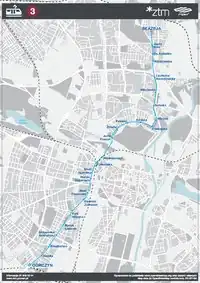 |
BŁAŻEJA - Praw Kobiet - Naramowicka - Przełajowa - Winogrady - Pułaskiego - Roosevelta - Głogowska - PST - SŁOWIAŃSKA | |
| 5 |  |
GÓRCZYN PKM - Głogowska - Roosevelta - Matyi - Królowej Jadwigi - Bolesława Krzywoustego - Rondo Rataje - Zamenhofa - Rondo Starołęka - Hetmańska - Rondo Żegrze - Unii Lubelskiej - UNII LUBELSKIEJ | |
| 6 |  |
JUNIKOWO - (BUDZISZYŃSKA) - Grunwaldzka - Rondo Nowaka-Jeziorańskiego - Grunwaldzka - Bałtyk - Roosevelta - Most Dworcowy - Królowej Jadwigi - Bolesława Krzywoustego - Rondo Rataje - Jana Pawła II - Rondo Śródka - Warszawska - MIŁOSTOWO | Every second tram's route is shortened to Budziszyńska. |
| 7 |  |
OGRODY - Dąbrowskiego - Przybyszewskiego - Rondo Nowaka-Jeziorańskiego - Reymonta - Hetmańska - Rondo Starołęka - Zamenhofa - Rondo Rataje - Jana Pawła II - Rondo Śródka - Podwale - ZAWADY | |
| 8 |  |
GÓRCZYN PKM - Głogowska - Roosevelta - Rondo Kaponiera - Roosevelta - Dąbrowskiego - OGRODY | |
| 9 | 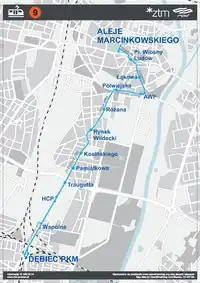 |
DĘBIEC PKM - 28 Czerwca 1956 - Górna Wilda - Królowej Jadwigi - Strzelecka - plac Wiosny Ludów - Podgórna - ALEJE MARCINKOWSKIEGO | |
| 10 |  |
BŁAŻEJA - Praw Kobiet - Naramowicka - Przełajowa - Winogrady - Pułaskiego - Roosevelta - Rondo Kaponiera - Roosevelta - Most Dworcowy - Wierzbięcice - 28 Czerwca 1956 r. - DĘBIEC | |
| 11 |  |
PIĄTKOWSKA - Winiarska - Wołyńska - Małopolska - Al. Wielkopolska - Pułaskiego - Roosevelta - Rondo Kaponiera - Roosevelta - Głogowska - Hetmańska - Rondo Starołęka - Hetmańska - Rondo Żegrze - Unii Lubelskiej - UNII LUBELSKIEJ | |
| 12 | 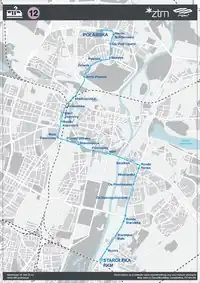 |
POŁABSKA - Rondo Solidarności - Murawa - Winogrady - Pułaskiego - Roosevelta - Rondo Kaponiera - Roosevelta - Matyi - Królowej Jadwigi - Bolesława Krzywoustego - Rondo Rataje - Zamenhofa - Rondo Starołęka - Starołęcka - STAROŁĘKA PKM | |
| 13 | 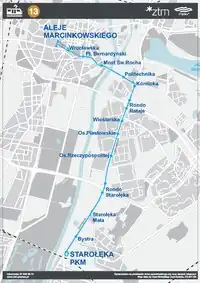 |
STAROŁĘKA PKM - Starołęcka - Rondo Starołęka - Zamenhofa - Rondo Rataje - Jana Pawła II - Kórnicka - Most św. Rocha - Dowbora-Muśnickiego - Plac Bernardyński - Lewandowskiej - Podgórna - ALEJE MARCINKOWSKIEGO | |
| 14 |  |
PIĄTKOWSKA - Winiarska - Wołyńska - Małopolska - Al. Wielkopolska - Pułaskiego - Roosevelta - Rondo Kaponiera - Roosevelta - Głogowska - GÓRCZYN | |
| 15 |  |
POŁABSKA - Rondo Solidarności - Murawa - Winogrady - Pułaskiego - Roosevelta - Rondo Kaponiera - Roosevelta - Bałtyk - Grunwaldzka - Rondo Nowaka-Jeziorańskiego - Grunwaldzka - JUNIKOWO | |
| 18 |  |
OGRODY - Dąbrowskiego - Roosevelta - Rondo Kaponiera - Roosevelta - Matyi - Królowej Jadwigi - Krzywoustego - Rondo Rataje - Zamenhofa - Rondo Starołęka - Hetmańska - Rondo Żegrze - Żegrze - Piaśnicka - FRANOWO | |
| 98 | 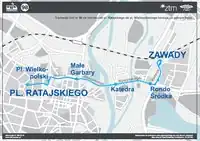 |
PLAC RATAJSKIEGO - 23 Lutego - Plac Wielkopolski - Wolnica - Małe Garbary - Estkowskiego - Wyszyńskiego - Rondo Śródka - Podwale - ZAWADY | |
| Tourist route | |||
| 0 |  |
GAJOWA - Zwierzyniecka - Kraszewskiego - Dąbrowskiego - Roosevelta - Rondo Kaponiera - Roosevelta - Matyi - Wierzbięcice - 28 Czerwca - ZAJEZDNIA MADALIŃSKIEGO - Hetmańska - Głogowska - Roosevelta - Rondo Kaponiera - Zwierzyniecka - GAJOWA
| |
Depots
- ul Głogowska depot
This is the second largest tram depot in Poznan (after Franowo). It was built in 1907 and underwent modernisation between 1998 and 2000 in preparation for low floor trams. It is close to the tram stop Krauthofera.
- Starołęka
This depot opened in 1980 at the Starołęka terminus. The construction began in 1974
- Franowo
This is the largest and newest depot in Poznan, opened on 11 May 2014. The depot has space for 100 trams.
The following depots have now closed:
- ul. Gajowa. This depot opened in 1880 and closed on 28 December 2010. (Reason: Sold in 2008, Because the Portuguese Investor Was Demanding Too Much Money From The Operator To Use The Depot)
- Budziszyńska. This was an overflow depot for ul. Głogowska and Madalińskiego. The depot closed on 4 November 2012. (Opened in 1985. Construction Began in 1982, To solve the issue of the lack of space of the 60s, 70s, and 80s. the reason was the trams that were At Bolesława Krzywoustego, Zwierzyniecka, Rondo Rataje, Przybyszewskiego and Towarowa were Vandalised
- ul Madalińskiego. This depot was built between 1947 and 1955 and closed on 14 December 2014. It was the smallest depot MPK operated. It is now used for the historical fleet.
- ul. Bolesława Krzywoustego. This depot was used in the 1980s and was located between Rondo Rataje and ul. Pleszewskiej.
Plans for further extension

Currently in Poznań there are several plans to extend the tram network; some of them are only planned, others are under construction:
- extension of the line from Ogrody along ul. Dąbrowskiego to al. Polska with new tram/bus station at the end of the route
- extension of route from Zawady alongside ul. Zawady and ul. Główna to Poznań Wschód station
- extension of route from Dębiec via ul. 28. Czerwca 1956 r. to os. Dębina
- new route via ul. Ratajczaka, Pl. Cyryla Ratajskiego, ul. Solna and ul. Nowowiejskiego
- new route to os. Kopernika alongside ul. Arciszewskiego and ul. Pogodna and new route on ul. Szpitalna and ul. Grochowska
- new route from ul. Garbary through ul. Szelągowska and ul. Naramowickiej to Naramowice connected with existing line to ul. Wilczak
Gallery
.jpg.webp) MPK mascots, Bimbolas[2]
MPK mascots, Bimbolas[2]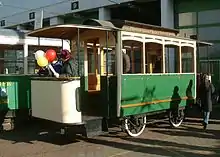 Herbrand B3/H0 Horse tram
Herbrand B3/H0 Horse tram Historic Konstal 4N+4ND
Historic Konstal 4N+4ND Historic Konstal 102N
Historic Konstal 102N Historic Konstal 102Na
Historic Konstal 102Na Historic Konstal 105N
Historic Konstal 105N Konstal 105Na+105NaD
Konstal 105Na+105NaD Konstal 105NaDK
Konstal 105NaDK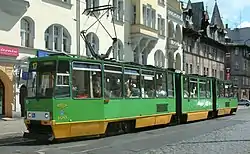 Konstal/HCP 105N2 (115N)
Konstal/HCP 105N2 (115N) Düwag GT6
Düwag GT6 Düwag GT8
Düwag GT8 Düwag GT-8ZR
Düwag GT-8ZR Historical tram depot on Gajowa Str.
Historical tram depot on Gajowa Str. Inside of depot on Głogowska Str.
Inside of depot on Głogowska Str. Technical car based on Konstal 4N1
Technical car based on Konstal 4N1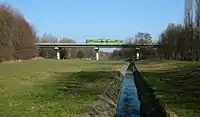 Tatra RT6N1 on overpass over Bogdanka, Poznański Szybki Tramwaj
Tatra RT6N1 on overpass over Bogdanka, Poznański Szybki Tramwaj
References
- Maria Trzeciakowska, Lech Trzeciakowski, W dziewiętnastowiecznym Poznaniu. Życie codzienne miasta 1815-1914, Poznań 1982, Wydawnictwo Poznańskie ISBN 83-210-0316-8
- Jerzy Topolski, Lech Trzeciakowski (red) Dzieje Poznania, tom II cz. 1 1793-1918, Warszawa-Poznań 1994, Państwowe Wydawnictwo Naukowe ISBN 83-01-11393-6
- Jerzy Topolski, Lech Trzeciakowski (red) Dzieje Poznania, tom II cz. 2 1918-1945, Warszawa-Poznań 1998, Państwowe Wydawnictwo Naukowe ISBN 83-01-12401-6
Notes
- Tramino and Moderus Beta trams go into service in Poznan Railway Gazette International 24 May 2011
- Redakcja (2010-06-01). "Dzień Dziecka z Bimbolą". Poznań Nasze Miasto (in Polish). Retrieved 2019-12-12.
